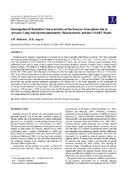| dc.description.abstract | Variations in the radiative characteristics of aerosols can be used to quantify their effects on climate. This study evaluated the temporal-spatial variability of aerosol radiative characteristics at λ = 440 nm, λ = 675 nm, λ = 870 nm and λ = 1020 nm over the Nairobi-1°S, 36°E, Mbita-0°S, 34°E and Malindi-2°S, 40°E sites of Kenya. Aerosol optical properties from AERONET were used as inputs in the Coupled Ocean Atmosphere Radiative Transfer (COART) code to model aerosol radiative effects. The results over Nairobi showed an increase in reflectance of 2.6%, 6.7%, 7.2% and 2.4% for 2006–2007 at the specified wavelengths, respectively. Drops of 2.7%, 12.2%, 50.6% and 25.6% were noted in the same wavelengths for the 2007–2008 period. The reflectance over Mbita (0.2284) was higher than that over Nairobi (0.1396) at λ = 675 nm for 2007, due to biomass burning at site. Maritime conditions and aerosols coupled with long range transport of monsoon winds explain the higher reflectance observed over Malindi when compared to Nairobi, except for λ = 440 nm in 2008. This is as a result of aerosols from vehicular and industrial emissions that dominate the λ = 440 nm over Nairobi. The variability of downward and upward spectral irradiance measured at the surface and 12 km levels depended on the wavelength of measurement, but was temporally invariant. Upward irradiance decreased with increasing Solar Zenith Angles (SZAs) due to strong Fresnel reflection at large angles. The equality in the upwelling irradiances at the two atmospheric levels at all sites for λ = 870 nm and λ = 1020 nm was due to the near IR absorption by aerosols. The radiant flux lost in the spectral range 440–1020 nm remained relatively constant over the study sites, and thus the influence of aerosols on radiative characteristics was independent of both site and period of study. | en_US |

